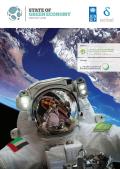
'The State of Green Economy Report 2016: Innovation on its Mind, and in its Pages' is a review and critical reflection of the findings of the World Green Economy Summit, held annually in October in Dubai. The report was developed by the Dubai Carbon Centre of Excellence (Dubai Carbon), Dubai Electricity and Water Authority (DEWA), the Dubai Supreme Council of Energy (DSCE) and in partnership with the United Nations Development Programme (UNDP).
The publication indexes green economic development, meanwhile, offering a platform for national and international experts, and thought leaders to share findings of research and development, solutions, tools, as well as replicable initiatives and case studies.
A contribution from the GGKP's Head, Benjamin Simmons, on 'Enabling Action with Green Growth Knowledge" can be found on pages 238-241 of the report.
As various countries explore the merits of green growth in their policies and programs, the Republic of Korea’s (ROK) transition toward green growth serves as an exemplary model.
This report examines why and how the ROK has pursued green growth as a national priority and as a development paradigm, sharing major milestones achieved in various areas such as greenhouse gas emissions, green technology, resource efficiency, and energy security. Drawing on the expertise of sector specialists and practitioners, the report highlights the processes, outcomes, and key takeaways in advancing green growth planning and implementation in the Korean context to address fossil fuel dependency, economic slowdown, and climate change. It highlights how a confluence of milestones created a strong enabling environment for green growth in the ROK, laying out the institutional, legal, and programmatic platform for green growth.

Rising energy demand and efforts to address climate change require a significant increase in low-carbon electricity generation. Yet, concern has been raised that rapid investment in some novel technologies could cause a new set of environmental problems.
This is a summary of the key findings of the International Resource Panel (IRP) report Green Energy Choices: The Benefits, Risks and Trade-Offs of Low-Carbon Technologies for Electricity Production which aims to support policy-makers in making choices about the technologies, infrastructures and energy sources. It does so through an analysis of the mainstream commercially available renewable and non-renewable power generation technologies3, analysing their GHG mitigation potential, but also tradeoffs in terms of: Environmental impacts (impacts on ecosystems, eutrophication and acidification, etc.) Human health impacts (particulates and toxicity) Resource use implications (iron, copper, aluminium, cement, energy, water and land).
Although there is progress in developing green sectors in some countries, the key challenge facing the expansion of economy-wide green innovation and structural change is the absence of relevant policy follow-up to the green stimulus enacted during the Great Recession. The boost to green sectors provided by such measures is waning quickly, given that much of the green stimulus focused on energy efficiency. The biggest obstacles to sustaining green growth are major market disincentives, especially the underpricing of fossil fuels and market failures to spur green innovation. A three-part strategy to overcome these obstacles would involve, first, removing fossil fuel subsidies, second, employing market-based instruments to further reduce the social costs of fossil fuel use, and third, allocating any resulting revenue to public support for green innovation and investments. Such a strategy would ensure that green growth is not about promoting niche green sectors but instigating economy-wide innovation and structural transformation.
Well-timed and targeted innovation boosts productivity, increases economic growth and helps solve societal problems. But how can governments encourage more people to innovate more of the time? And how can government itself be more innovative?
This report argues that policy makers can and should do better in marshalling the power of innovation to achieve core objectives of public policy such as green growth. Policies for innovation require a strategic approach. The OECD Innovation Strategy provides a set of principles to spur innovation in people, firms and government. It takes an in-depth look at the scope of innovation and how it is changing, as well as where and how it is occurring, based on updated research and data.
